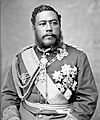Hawaiian Kingdom facts for kids
Quick facts for kids
Hawaiian Kingdom
Aupuni Mōʻī o Hawaiʻi
|
|||||||||||||
|---|---|---|---|---|---|---|---|---|---|---|---|---|---|
1893–1895: Government-in-exile |
|||||||||||||
|
|
|||||||||||||
|
Motto:
|
|||||||||||||
|
Anthem:
|
|||||||||||||

Hawaiian Kingdom
|
|||||||||||||
| Capital |
|
||||||||||||
| Common languages | Hawaiian, English | ||||||||||||
| Religion | Church of Hawaii | ||||||||||||
| Government | Absolute monarchy (until 1840) Constitutional monarchy (from 1840) |
||||||||||||
| Monarch | |||||||||||||
|
• 1795–1819
|
Kamehameha I (first) | ||||||||||||
|
• 1891–1893
|
Liliʻuokalani (last) | ||||||||||||
| Kuhina Nui | |||||||||||||
|
• 1819–1832
|
Kaʻahumanu (first) | ||||||||||||
|
• 1863–1864
|
Kekūanāoʻa (last) | ||||||||||||
| Legislature | Legislature | ||||||||||||
| House of Nobles | |||||||||||||
| House of Representatives | |||||||||||||
| History | |||||||||||||
|
• Inception
|
May, 1795 | ||||||||||||
| March/April 1810 | |||||||||||||
| October 8, 1840 | |||||||||||||
| February 25 – July 31, 1843 | |||||||||||||
|
• Anglo-Franco Proclamation
|
November 28, 1843 | ||||||||||||
| January 17, 1893 | |||||||||||||
|
• Abdication of Queen Liliʻuokalani
|
January 24, 1895 | ||||||||||||
| Population | |||||||||||||
|
• 1780
|
400,000 – 800,000 | ||||||||||||
|
• 1800
|
250,000 | ||||||||||||
|
• 1832
|
130,313 | ||||||||||||
|
• 1890
|
89,990 | ||||||||||||
| Currency |
|
||||||||||||
|
|||||||||||||
| Today part of | |||||||||||||
The Hawaiian Kingdom (also called Kingdom of Hawaiʻi) started in 1795. This was when the separate islands of Hawaiʻi, Oʻahu, Maui, Molokaʻi, and Lānaʻi joined together under one government. By 1810, all the Hawaiian Islands were united. This happened when Kauaʻi and Niʻihau chose to join the Kingdom of Hawaiʻi.
Two main royal families ruled the kingdom: the House of Kamehameha and the House of Kalākaua. Other powerful countries in Europe recognized Hawaii as its own kingdom. The United States became Hawaii's most important trading partner. The U.S. also kept an eye on the Kingdom to make sure no other country, like Britain or Japan, tried to take control.
In 1887, Hawaii had to accept a new constitution. This happened because King Kalākaua was threatened by a group called the Honolulu Rifles. This group was against the monarchy. Queen Liliʻuokalani, who became queen in 1891, tried to change this constitution. She wanted to create a new one. However, she was overthrown in 1893. This was mainly done by the Committee of Safety. This group included Hawaiian citizens and people from America, Britain, and Germany. Many of them had studied in the U.S. and felt very American. After this, Hawaii became a republic. Then, in 1898, the United States officially took over Hawaii. This was done through a law called The Newlands Resolution. Hawaii then became the Territory of Hawaii.
Contents
The Start of the Hawaiian Kingdom
The Hawaiian Kingdom began when different islands came together. This happened in 1795 under the rule of Kamehameha I. He was a powerful leader who brought many islands under his control.
How Hawaii Became One Kingdom
- 1795: The islands of Hawaiʻi, Oʻahu, Maui, Molokaʻi, and Lānaʻi joined together. This created the first united government.
- 1810: The last two islands, Kauaʻi and Niʻihau, chose to join the kingdom peacefully. This completed the unification of all the Hawaiian Islands.
Important Rulers of Hawaii
The Hawaiian Kingdom was led by two main royal families. These families guided the country for many years.
The Kamehameha Family
The first ruling family was the House of Kamehameha. They established the kingdom and helped it grow.
- Kamehameha I (1795–1819): He was the first king and united the islands.
- Other Kamehameha Rulers: Several other kings from this family followed, working to make Hawaii a strong nation.
The Kalākaua Family
Later, the House of Kalākaua took over. They faced new challenges as more foreign countries became interested in Hawaii.
- King Kalākaua (1874–1891): He traveled the world and tried to protect Hawaii's independence.
- Queen Liliʻuokalani (1891–1893): She was the last monarch of Hawaii. She tried to restore the power of the Hawaiian people.
Hawaii's Place in the World
The Hawaiian Kingdom was recognized by many powerful countries. This meant they saw Hawaii as a real and independent nation.
Friends and Trading Partners
- European Powers: Countries like Britain and France saw Hawaii as a sovereign state.
- United States: The U.S. became Hawaii's main partner for trade. They also watched over Hawaii to prevent other countries from taking control.
Challenges to the Kingdom
Even though Hawaii was independent, it faced many challenges. Foreign influence grew stronger over time.
The 1887 Constitution
In 1887, King Kalākaua was forced to sign a new constitution. This document, known as the "Bayonet Constitution," took away much of the king's power. It also gave more power to foreign residents.
- Why it happened: A group called the Honolulu Rifles, who were against the monarchy, threatened the king.
The Overthrow of the Monarchy
Queen Liliʻuokalani tried to create a new constitution. She wanted to give power back to the Hawaiian people. However, a group called the Committee of Safety worked to remove her from power.
- January 17, 1893: Queen Liliʻuokalani was overthrown.
- Aftermath: Hawaii became a republic for a short time. Then, in 1898, the United States annexed Hawaii, making it a U.S. territory.
Images for kids
-
King Kalākaua meeting U.S. President Grant at the White House, 1874
-
On August 12, 1898, the flag of the Hawaiian Kingdom over ʻIolani Palace was lowered to raise the United States flag to signify annexation.
-
Kawaiahaʻo Church is known as the Westminster Abbey of Hawaiʻi, the site of coronations, royal christenings and funerals.
See also
 In Spanish: Reino de Hawái para niños
In Spanish: Reino de Hawái para niños












